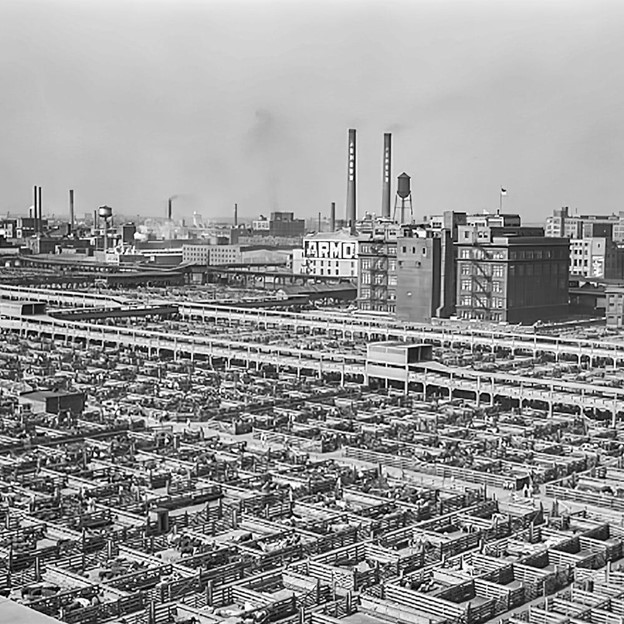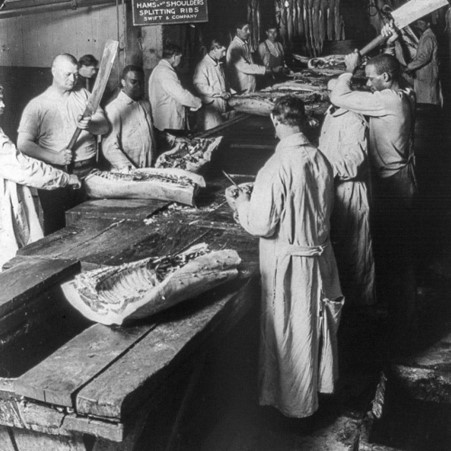One Health Newsletter
Unveiling the One Health Paradigm: Exploring its Roots in the Chicago Stockyards
Author
Antoinette EF Lona, M.S.
Introduction
The Chicago Stockyards, emblematic of industrialization's impact on public health, were pivotal in shaping the One Health paradigm, which emphasizes the interconnectedness of human, animal, and environmental health.1 Characterized by poor working conditions and frequent disease outbreaks among workers and livestock,2 these conditions underscored the need for integrated health approaches. Upton Sinclair's novel, The Jungle, further illuminated these issues, raising public awareness and catalyzing regulatory reforms.3 Sinclair's exposé not only exposed the harsh realities of the stockyards but also underscored the interdependencies between human health, animal welfare, and environmental sustainability—fundamental principles of the One Health framework.4
Historical Context: The Rise of the Chicago Stockyards
The Union Stockyards, situated four miles south of downtown Chicago, encompassed 450 acres of pens and slaughterhouses where livestock from various states were gathered and subsequently distributed nationwide. Farmers were obligated to pay fees for the maintenance of their animals, including feeding and watering, during their stay at the stockyards.5 The concept of the "Union Stockyard Era" in slaughterhouse history underscores the centralization of animal slaughter in urban hubs. This approach was driven by the cost-effectiveness of slaughtering animals at centralized locations and transporting carcasses to markets, rather than transporting live animals. The stockyards transformed Chicago into the nation's meatpacking hub by the mid-19th century.2

Stockyard pens covered a square mile of Chicago during its peak circa 1924. (Source: Library of Congress)
Key factors in this transformation included the city's strategic location, access to waterways, and refrigerated railcars.6 These innovations enabled the efficient transport of livestock and meat products, contributing to the stockyards' rapid growth. The introduction of refrigerated railcars also revolutionized the industry, allowing for longer-distance shipping and reducing spoilage rates.2 Technological advancements and assembly-line methods revolutionized meatpacking, significantly increasing efficiency and output.6 The mechanization of slaughtering and processing operations has not only accelerated production but also intensified the scale of meatpacking activities, thereby amplifying the health and environmental challenges associated with the stockyards.
Socio-Economic Implications
The stockyards influenced Chicago's demographics and labor dynamics, attracting immigrants seeking employment.2 This population surge contributed to cultural diversity and led to overcrowded, impoverished neighborhoods with harsh working conditions. Immigrants from Eastern and Southern Europe and African Americans migrating from the South were drawn to Chicago by the promise of jobs. However, they often found themselves living in squalid conditions, with limited access to healthcare and other essential services. The living conditions in these neighborhoods were a breeding ground for diseases, further complicating public health efforts.7
The stockyards became a center for labor activism. Labor unions advocated for workers' rights, fighting for better wages, safer working conditions, and more humane treatment. In 1902, Union Stockyard workers demanded a wage increase and overtime pay for their grueling 16–18-hour shifts. When the owners refused their request, allied industries, including railroad workers, express company drivers, meat box manufacturers, ice wagon drivers, and coal workers from refrigeration plants, acted in solidarity by refusing to handle anything related to the stockyards and meatpacking industry. This strike highlighted the interconnectivity of different sectors of industrial labor and the support among working-class communities for the struggles faced by other industries.8
This period of activism and reform laid the groundwork for future labor movements across various industries. Furthermore, an official report cited that Sinclair’s novel was a turning point in the improvement of food safety laws due to the poor sanitary conditions in stockyards and meatpacking operations. Sinclair persuaded President Theodore Roosevelt to assign federal inspectors to meatpacking houses, leading to significant reforms. Two federal laws were passed about the growing concerns of food safety concerns in both slaughterhouses and meatpacking houses— (1) The Federal Meat Inspection Act and (2) The Pure Food and Drug Act 3.
Health Hazards in the Stockyards
Unsanitary conditions in the stockyards led to the transmission of infectious diseases like tuberculosis, brucellosis, and anthrax among workers and livestock.1,3 Zoonotic diseases, transmitted from animals to humans, posed significant risks, exacerbated by the crowded work conditions where workers and animals had very close interaction. There was also no proper bathroom for the workers, who had to use a corner of the slaughterhouse as a makeshift bathroom. Workers who processed bones for fertilizers often contracted lung disease, while tanners developed sores and cuts on their fingers due to the lack of gloves when working with chemicals. The physical demands of meatpacking work, combined with the lack of proper hygiene and safety measures, also made workers highly susceptible to injuries.
Moreover, the stockyards' layout and operations facilitated rapid disease spread. Workers often brought home pathogens, infecting their families and contributing to community-wide health crises. The lack of adequate medical facilities and public health infrastructure further aggravated the situation, as many workers could not afford medical care.

A hog being butchered at Swift & Company in 1905 (Source: Library of Congress)
Environmental Degradation and Public Health
The stockyards' operations resulted in significant environmental pollution, contaminating ecosystems and water supplies with animal waste and industrial pollutants.2 This contamination contributed to waterborne illnesses and environmental degradation. The Chicago River, which flowed adjacent to the stockyards, became heavily polluted with blood, offal, and other waste products, creating a toxic environment for wildlife and humans. Waste management efforts were often inadequate, leading to persistent environmental and public health issues. Air pollution further exacerbated health risks, causing respiratory ailments among nearby residents. The smoke and odors emanating from the stockyards permeated the air, leading to chronic respiratory conditions such as asthma and bronchitis.
Human-Animal-Environment Interconnections
Sinclair's work revealed the transmission of zoonotic diseases like tuberculosis and brucellosis, underscoring the health risks associated with close human-animal interactions.3 The stockyards' complex dynamics made it a fertile ground for disease transmission, as workers and livestock coexisted in densely packed, unsanitary conditions. Workers often experience various occupational illnesses directly attributed to their environment, illustrating the impact of animal health on human well-being. Environmental degradation further emphasized the need for an all-inclusive health management approach. Stockyard pollution compromised environmental integrity and posed health risks to nearby communities.2 The massive quantities of waste produced by the stockyards overwhelmed the local waste management infrastructure, leading to severe air, water, and soil contamination. These pollutants contributed to various health issues, including respiratory problems and gastrointestinal diseases among the local population.
The Dawn of One Health
Amid disease and environmental challenges, scholars, public health officials, and veterinarians recognized the relationship between human, animal, and ecosystem health.9 The stockyards served as a testing ground for early interdisciplinary collaborations, as veterinarians worked alongside public health officials to implement measures to curb disease spread among livestock and humans. These efforts laid the groundwork for a holistic health management approach that transcended traditional disciplinary boundaries. Pioneering public health efforts in the stockyards included the establishment of hygiene protocols and the development of vaccines for common zoonotic diseases. These initiatives were critical in reducing disease incidence and improving overall health outcomes. The collaboration between different health disciplines at the stockyards provided a model for future One Health initiatives, demonstrating the effectiveness of integrated approaches to health management.
Legacy and Impact
Lessons from the Chicago Stockyards continue to influence public health. Recognition of unified health paved the way for formalizing the One Health paradigm in the 21st century.1 Today, One Health is supported by organizations like the World Health Organization (WHO) and the Centers for Disease Control and Prevention (CDC), providing a guiding framework to address complex global health challenges, including the emergence of infectious and antimicrobial resistance. The principles of One Health are increasingly becoming more relevant in addressing contemporary issues like climate change, biodiversity loss, and pandemics.9 The Chicago Stockyards' legacy serves as a reminder of the importance of integrated health strategies in ensuring the well-being of humans, animals, and the environment.
Conclusion
The legacy of the Chicago Stockyards is intricately woven into the history of One Health, as the recognition of the interdependence between human, animal, and environmental health emerged from the industrial and environmental challenges posed by the stockyards. The Chicago Stockyards' legacy underscores the necessity of breaking down disciplinary silos and fostering collaboration among public health, veterinary, and environmental professionals. As we confront the complex health challenges of the 21st century, including pandemics and climate change, the One Health paradigm provides a comprehensive framework for understanding and addressing the intricate interdependencies that define our world.
References
- Hill L. The Chicago River. Lake Claremont Press; 2000.
- Fisman DN, Laupland KB. The “One Health” paradigm: Time for infectious diseases clinicians to take note? Canadian Journal of Infectious Diseases and Medical Microbiology. 2010;21(3):111-114.
- Sinclair U. The Jungle. Ten Speed; 1906.
- Cronon W. Nature’s Metropolis: Chicago and the Great West. W.W. Norton; 1991.
- Chicago Stories. The Union Stockyards: A Story of American Capitalism. WTTW. Accessed August 1, 2024. https://interactive.wttw.com/chicago-stories/union-stockyards/the-union-stockyards-a-story-of-american-capitalism.
- Best S, Kahn R, Nocella A, McLaren P. The Global Industrial Complex: Systems of Domination. Lexington Books; 2011.
- The History. Chicago Race Riot of 1919 Commemoration Project. Accessed August 1, 2024. https://chicagoraceriot.org/history/great-migration/.
- Cohen L. Making a New Deal: Industrial Workers in Chicago, 1919-1939. Cambridge University Press; 2014.
- Clark SRL. The Moral Status of Animals. Oxford University Press; 1984.